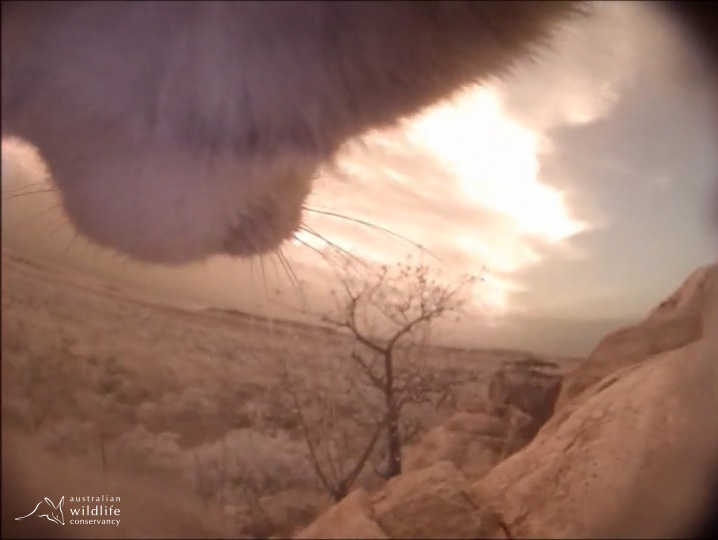Australian Wildfires Provide Surprise Boon for Hunting Cats

Radio collars and video cameras are helping conservationists in Australia track the habits of feral cats better than ever before, improving scientists' understanding of the animals' hunting habits.
And while developing a clearer picture of the cats' movements, researchers have discovered that the feral felines are benefitting from an unexpected and deadly ally: wildfires.
In an article published by the Australian Wildlife Conservancy (AWC) in the autumn 2016 issue of Wildlife Australia magazine, scientists said they found that feral cats hunted more successfully in areas that had been burned by wildfires. This suggests that fire management practices could play an important role in future policies for controlling and eradicating these predatory pests, the authors wrote. [In Photos: The Peskiest Alien Mammals]
Shipwreck survivors
Cats are not native to the Australian continent. They are known to have arrived with European settlers but may have reached Australia from Dutch shipwrecks as early as the 17th century, according to a report by the Australian Government Department of the Environment (AGDE). Farmers and homesteaders are known to have deliberately released cats in the wild during the late 1800s to control agricultural pest mammals like mice and rats. The feral cats that emerged are the same species as domestic cats, but live and hunt entirely in the wild and have no contact with people.
With few natural predators and a bountiful selection of wildlife to prey upon, feral cat populations boomed, skyrocketing to approximately 4 million distributed across Australia today. Feral cats kill millions of native Australian animals daily, according to the AWC. The AGDE links feral cats to the extinction of some species of small mammals and ground-dwelling birds, and to the continued decline of several endangered animals in Australia.
To combat this threat to Australia's native species, the AWC is currently conducting the most comprehensive research project on feral cats in the country's history. The organization used infrared camera traps, fitting feral cats with customized cameras and radio collars holding GPS units in order to gather data on population densities, where the cats ranged and how they hunted.
Trial by fire
The researchers conducted their five-year observation of the cats on the Mornington-Marion Downs wildlife sanctuary, where the AWC also maintains a fire-management program. There, the scientists used controlled fires to create boundaries within a landscape, preventing larger fires from burning out of control.
Sign up for the Live Science daily newsletter now
Get the world’s most fascinating discoveries delivered straight to your inbox.
In the article, published March 2 in the journal Scientific Reports, the scientists explained that the strongest pattern they discovered among the cats was how they used areas that had been scorched by fires, particularly areas that suffered heavy fire damage, like what severe wildfires would leave behind.
Cats appeared to target fire-scarred parts of habitats, sometimes traveling up to 8 miles (12 kilometers) outside their normal territorial ranges to hunt in scorched zones. Newly burnt areas hosted about four times the usual number of cats. The researchers described cats arriving about two weeks after a fire had burnt itself out, and staying for several weeks to hunt.
Fires also affected the survival rates of the cats' prey, the scientists found. They observed 100 hunts, and saw that in a singed habitat, prey's chances of surviving an attack were about 20 percent, while their chances in an area with dense vegetative cover were closer to 80 percent.
This is the first evidence suggesting a link between fires and the hunting habits and success of feral cats. Deploying controlled, low-intensity fires could benefit small animals that the cats hunt by protecting the prey's habitats from the more damaging fires that benefit feral cats. As conservationists develop new strategies for containing feral cat populations, fire management may emerge as an unexpected and effective method for protecting vulnerable native wildlife, the authors wrote.
Follow Mindy Weisberger on Twitter and Google+. Follow us @livescience, Facebook & Google+. Original article on Live Science.

Mindy Weisberger is an editor at Scholastic and a former Live Science channel editor and senior writer. She has reported on general science, covering climate change, paleontology, biology and space. Mindy studied film at Columbia University; prior to Live Science she produced, wrote and directed media for the American Museum of Natural History in New York City. Her videos about dinosaurs, astrophysics, biodiversity and evolution appear in museums and science centers worldwide, earning awards such as the CINE Golden Eagle and the Communicator Award of Excellence. Her writing has also appeared in Scientific American, The Washington Post and How It Works Magazine. Her book "Rise of the Zombie Bugs: The Surprising Science of Parasitic Mind Control" will be published in spring 2025 by Johns Hopkins University Press.









